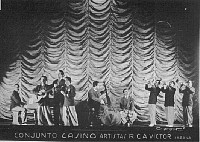10.4.2 The Sets.

Similar to what happened in the 1920s with the sextets, the first two Conjuntos, Arsenio Rodríguez’s and Conjunto Casino, established a model that many other groups immediately followed. The inclusion of other instruments in the group involved a shift in their functions, making their sound and harmony more encompassing.
Conjuntos were formed so that the musical volume would fill large venues and open-air spaces. They were structured by doubling the trumpets, including the piano, which reinforced the harmonic tumbaos of the bass and filled the space with sound, while the tumbadoras introduced new rhythms that varied in dialogue with the bongos and allowed for a different kind of bodily expression in the dance halls. The bell or cowbell also played a prominent role, adding a swaggering touch to the change of pace in the montuno.
Arsenio Rodríguez added to the sones repertoire a series of refrains taken from the festivals and dances of Afro-Cuban groups, such as the yuka and makuta drums. He stylized the Guaguancó, using tumbaos on the tres, which he called Guaguancó-Son. This had a slower feel. He also introduced timbilla rumbas, with a faster tempo, Columbia rumbas, and Afros that allowed for vocal virtuosity and percussive layers in the voices. He also returned to Son Montuno as it originally existed, but adapted to its instrumental format. In these sones, he also used proverbs and sayings from ancient yuka songs, which the soloists alternated with improvisations of décimas and quatrains or couplets with boastful content.
Proof of its validity can be found in the dance music of Cuba and the Americas, aside from possible substitutions or additions that do not define the essence of the sound achieved by the Conjunto. Arsenio himself would occasionally add instruments such as the paila, flute, saxophone, and güiro to the original sound structure in the late 1950s and 1960s.
Conjunto Casino had a similar format: four alternating solo singers, and their main repertoire was the danceable Bolero and the Guaracha. This ensemble achieved great national and international fame for its tours and the numerous recordings it made. The piano and tres were fundamental, despite being instruments with harmonic and percussive functions. These were used for short “descargas” (plays) in which the instrumentalists showed off their musical abilities.
Several Cuban instrumentalists and performers passed through both ensembles, making changes in their artistic success, but both always retained their essential character and great talent.








